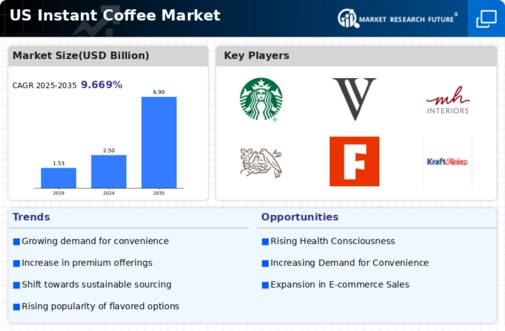Health and Wellness Trends
The instant coffee market is increasingly influenced by the growing health and wellness movement among consumers. As individuals become more health-conscious, they seek beverages that align with their lifestyle choices. Instant coffee, particularly varieties that are organic or enriched with functional ingredients, is gaining traction. Research indicates that around 30% of consumers are now opting for healthier coffee alternatives, which has prompted brands to innovate and offer products that cater to this demand. Furthermore, the potential health benefits associated with coffee consumption, such as improved cognitive function and antioxidant properties, are being highlighted in marketing strategies. This alignment with health trends is likely to bolster the instant coffee market, as consumers prioritize both taste and wellness.
Innovative Product Offerings
Innovation plays a crucial role in the instant coffee market, as manufacturers continuously develop new products to cater to evolving consumer preferences. The introduction of premium instant coffee options, such as single-origin and specialty blends, has attracted a more discerning customer base. Additionally, the rise of instant coffee pods and sachets has transformed the way consumers enjoy their coffee, providing both convenience and quality. Recent data indicates that the premium segment of the instant coffee market has grown by approximately 20% over the past year, highlighting a shift towards higher-quality offerings. This trend suggests that consumers are willing to invest more in their coffee experience, thereby enhancing the overall appeal of the instant coffee market.
Sustainability and Ethical Sourcing
Sustainability has emerged as a pivotal driver in the instant coffee market, as consumers increasingly prioritize environmentally friendly products. The demand for ethically sourced coffee is on the rise, with many consumers willing to pay a premium for brands that demonstrate a commitment to sustainability. Recent surveys indicate that approximately 40% of consumers consider sustainability when purchasing coffee products. This trend has prompted instant coffee manufacturers to adopt sustainable practices, such as using recyclable packaging and supporting fair trade initiatives. By aligning with consumer values, brands can enhance their reputation and foster loyalty among environmentally conscious customers. The focus on sustainability is likely to continue shaping the instant coffee market, as consumers seek products that reflect their ethical considerations.
Rising Demand for On-the-Go Solutions
The instant coffee market experiences a notable surge in demand for convenient beverage options, particularly among busy consumers. As lifestyles become increasingly fast-paced, individuals seek quick and easy solutions for their caffeine needs. This trend is reflected in the growing sales of instant coffee products, which have seen an increase of approximately 15% in the last year alone. The ability to prepare a cup of coffee in mere minutes appeals to professionals, students, and travelers alike. Furthermore, the instant coffee market benefits from the expansion of retail channels, including online platforms, which facilitate easy access to a variety of instant coffee brands. This shift towards on-the-go consumption is likely to continue driving growth in the market, as consumers prioritize convenience without compromising on taste.
E-commerce Growth and Digital Marketing
The instant coffee market is witnessing a significant transformation due to the rapid growth of e-commerce and digital marketing strategies. With more consumers turning to online shopping for their coffee needs, brands are adapting their marketing approaches to reach a broader audience. Recent statistics reveal that online sales of instant coffee have increased by approximately 25% in the past year, indicating a shift in purchasing behavior. Companies are leveraging social media platforms and targeted advertising to engage consumers and promote their products effectively. This digital shift not only enhances brand visibility but also allows for personalized marketing, which resonates with consumers. As e-commerce continues to expand, the instant coffee market is likely to benefit from increased accessibility and consumer engagement.





















Leave a Comment